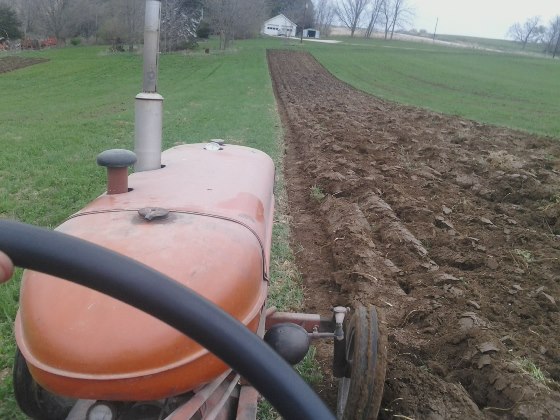can't recall just where I found this article, but it addresses the twisted belt topic very well. I think I was looking for some explanation of 'crowned pulleys' at the time.
Twisted Belt
Providing power to a threshing machine is a mix of science and
serendipity.
The threshing machine
became reality largely due to the advent of the steam
traction engine. These
behemoths were difficult to maneuver, fire belching
boilers that required a
crew to operate. Thus most other farming tasks
continued to be done
with horses. This included delivery of the unthreshed
crop to the thresher as
well as hauling away the cleaned grain.
The threshing machine
itself was a linear arrangement whereby the raw crop
was put into the feeder
with the cleaned grain emerging somewhere amidships
and the straw and other
effluent expelled from the rear. The threshing
machine, usually wooden
bodied in the early versions, processed highly
flammable product. The
steam boiler was a noisy, smoke and fire emitting
dragon that frightened
the horses and threatened the product. A long belt
was thus used to allow
removing the power unit from the immediate vicinity.
It was also difficult to
exactly align the driveR and driveN shafts. The
greater the separation
between dR and dN, the less the impact of
non-parallel shafts.
The 180 degree twist in
the belt has effect in three broad categories;
tracking, stability and
efficient power transmission.
1) Tracking. A flat belt
generally tracks to the high (or tight) side. It
will climb on a drive
that is not perfectly aligned. Twisting the belt
averages the edge
tension to reduce that effect. This is not a cure-all.
The system must still be
carefully aligned. The twist will make the belt
path stable but too much
alignment error will cause the belt to run inboard
on one pulley and
outboard on the other. Obviously pulley width is the
limiting factor. Crowned
pulleys can also help.
2) Drive stability. This
is a catch-all category the includes several
topics such as belt
droop, belt "flop", belt operating envelope; all of
which greatly impact
operational safety.
The longer the belt
span, the greater the effect of tight side versus slack
side tension. On a
threshing machine drive the slack side of an untwisted
belt can actually drag
on the ground. The flywheel of the power unit
provides relatively
stable drive input. The threshing unit however will
surge greatly depending
on the variations in product throughput. Thus the
slack side droop can
vary wildly. If this belt flop remained in the strict
vertical plane it might
be acceptable. However in practicality, a wildly
gyrating belt can throw
itself from the drive resulting in a long, 100+
pound unguided
projectile. Even if the belt stays on the drive, the flop
and slap will scare the
horses who must stand patiently as the rack they are
drawing is emptied.
Excessive flop will also tend to relocate over time the
dR and/or dN units thus
further impacting system alignment and tension.
A 180 degree twist
toward the center of the belt span serves to limit the
drive envelope
variations, a boon to machine, man and beast. Also, a minor
but important feature of
twisting the belt drive is to limit trash enclusion
in the drive. Trash is
either rejected outright or gets cleared as the belt
surfaces invert.
3) Efficient power
transmission. Perhaps the single most critical element
in a flat belt drive
system is pulley wrap. The greater the surface
wrapped, the greater is
the drive's power capability. A twist in the belt
both maximizes and
stabilizes pulley wrap. With equal diameter pulleys and
a twist in the belt one
can get better than 180 degree wrap (increased drive
rating for the same belt
dollar).
Although not such a fire
hazard, the less massive firing engine tractors are
not as inherently stable
a power source as is the steam engine. This
increases all negative
elements of the drive and makes it even more
desirable to have a
twist in the drive belt.
gatz
Edited by Gatz in NE - 11 Apr 2017 at 9:57pm









 Topic Options
Topic Options


 Post Options
Post Options Thanks(0)
Thanks(0)





